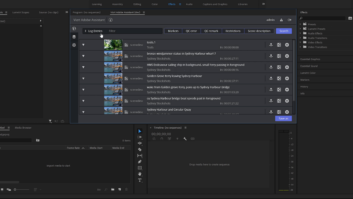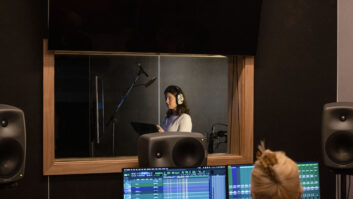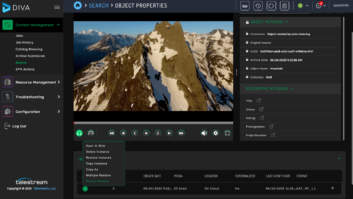
A productive way to separate the metaphorical wood from the trees in MAM-land remains to consider the extent to which projects (and products) exhibit the following characteristics: Are they production-leaning; distribution-leaning; content-manipulation related, or some combination of all of these? Columnist Mark Hill takes us on an insider view through the current MAM landscape.
It continues to be as difficult as ever to find a single MAM system that is proficient at all key parameters; production, distribution and content-manipulation. A MAM system having its roots in deep documentation of content for archiving is unlikely to have equal strength in marshalling content for distribution and delivery to TV linear playout and/or Video On Demand (VOD) outlets.
Most organisations now accept that adopting a more tactical/functional/workgroup approach to MAM, leading to the inevitable deployment of multiple MAM systems, is the way forward. This emphasises the increasing expectation that any one MAM system should be able to readily interoperate with those other systems adjacent to it.
Much has been written about Service Orientated Architecture (SOA) and its applicability to MAM. Many MAM suppliers have opened their systems to some degree to facilitate their easier interconnection. Traditional ‘rack and stack’ industry systems integrators have yet to show significant appetite for providing the software ‘glue’ between MAM and other IT-heavy production and broadcast systems, leaving many customers to take on this task in-house.
Customers however remain wary of MAM projects becoming heavily dependent on inherently complex, IT integrations, which can easily tie themselves into a long-winded and expensive knot. They should continue to be so.
Common to all areas of today’s application of MAM is the automation of business processes and workflows. Customers continue to turn to MAM suppliers and expect this as a strength, regardless of which part of the content value chain other aspects of the product may be pitched at.
Here, a high degree of self-configurability by the user remains a frequent demand, as customers seek freedom from expensive after-sales support contracts and suppliers seek competitive advantage through proving that system functionality really can be tailored (configured) to beneficial effect without recourse to coding by their own developers. Some useful advances have been made here, with more to come as MAM products continue to mature.
Everybody is special
Bespoke coding in MAM systems continues to be a troublesome issue for all parties and one best avoided where alternatives exist. Customers across the industry will naturally tend to regard their requirements set for MAM as unique and their businesses as unique.
Of course they all are, in so far as drawing a line on a piece of paper creates something unique; but to what extent does such uniqueness have a (business) value when compared with another line drawn on another piece of paper?
MAM continues to be associated with major change within adopting organisations. An excess of constraints and ‘unique to us’ in MAM requirements can be an indication that the organisation itself is resistant to change and may be missing out on potential benefits as a result. A rule of thumb used to be that 33% of a major MAM project budget might need be set aside for what was effectively custom coding by the manufacturer. Such proportions are now, thankfully, diminishing.
Watching the cloud go by
You recall the old joke. Question: What’s got the biggest bandwidth in London’s Soho post district? Answer: The courier’s white van full of video tapes!
Broadcasters have been wrestling for many years now with the logic of giving their content ‘crown jewels’ to third parties for off-site storage. A serious decision for finished or archive assets — essentially static items, with access required relatively infrequently.
Doing the same for work-in-progress (WIP) content, with it needing to be accessed on a far more interactive basis, by multiple users, remains a challenge. ‘Intermediate’ solutions have been built and operated successfully for proxy editing, with transfers and/or remote conforming of corresponding hi-resolution content — but there are few signs that customers or suppliers expect interactive, frame-by-frame manipulation of high-resolution content held remotely to happen anytime soon.
The recent ‘glitch’ in the BBC’s collaborative production system at Salford Quays(pictured), where up to 30 edit seats were affected by a crash in central storage, serves as a reminder of just how badly behaved entirely locally-based MAM systems can be.
Cloud computing will continue to evolve. It already represents a viable way forward for the corporate IT software application layer. No particular stretch perhaps when the smartest thing this layer has to interact with is an office printer.
MAM software applications however are still tightly coupled to adjacent production and broadcasting tech and to Gigabytes and more of content. Trying to run before we can walk, forcing our requirements and solutions skywards, could easily result in operations mired in expensive and practically useless Service Level Agreements (SLA) that can neither run nor walk come the next video frame.
Transcoded but not cured
Conceptually MAM remains the straightforward proposition it has been since the term was coined well over a decade ago: simply about what content you have; where that content is; and whether you can use it. Of course, a simple glance through any list of exhibitors in an industry show catalogue will reveal the full extent that suppliers have bent, stretched and generally re-written the above definition to suit their products and position in the market. Customers too have pulled the straightforward proposition of MAM into different directions to suit their specific objectives, usually around the need for improved overall workflow and business efficiency.
The practical reality of MAM however remains stubbornly complex. Chief among the technical issues that continues to hound MAM implementations remains that of ‘formats’. At BVE 2012 in February, Andy King from Vision Productions, BBC, delivered a presentation entitled: “Is 100 Mbps enough for broadcasters”. In this presentation, King opined that the choice of codec defines everything. It determines quality; bandwidth; storage.
He also reminded the audience that the ‘plate of spaghetti’ that the industry sits in front of on a daily basis consists of a bewildering mix of 20, or more codecs, combined with an easy half-dozen acquisition physical file storage formats, combined with another good half-dozen production/broadcasting related functions, such as viewing, logging, editing, colouring.
Back in the day, copying of content between videotapes (with comparatively few tape formats involved) was the norm. This was the sole means to facilitate parallel access to recorded content for processing and/or to take advantage of the unique features of some particular piece of station apparatus.
Today, transcoding has emerged as the necessary evil that has replaced tape copying. It’s mostly automated, thankfully, but it still takes time (and not an negligible amount, particularly for HD) and requires significant investment in hardware, software and integration to MAM and other systems. While transcoding massages the symptoms, the industry continues to search for a cure in what has become an ocean of format choices. Progress?
Future-proofing and Play-ability
If the growth in the (digital) broadcasting side of our industry has taught us anything in the past 15 years, then it must surely be that content pulled from archives can be exploited to make money, but knowing which content … well, that is only truly possible with hindsight! This leads us logically to the adoption of a ‘save everything’ approach. Fortunately, the shrinking physical size (and cost) required for storage of file-based content supports and encourages such an approach, but there are other factors to be considered too.
At some future point in time, that content you have on your shelf, held on a videotape, will not be playable. This will be due to there being no machines left on which to play it, or else the cost of access time for the one machine left in the world that can play it being judged as too high. Nobody is going to make a new machine when all the machines are gone.
If you have not migrated that content to some other format that is still playable by such time, then the content will become lost and your opportunity to make money from it also lost. Let’s not forget that this is true in the file-based content world also. How many of us can today open a file produced on a word processor 25 years ago and make use of its contents?
Nothing lasts forever, so it is vital that the industry gets to grips with automated migration of content and avails itself of open formats (including codecs — there they are again!) to ensure use at any time in the future. The former will increasingly be expected of MAM and is an area that remains as yet largely undeveloped.






